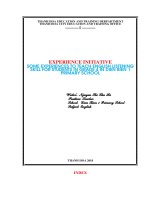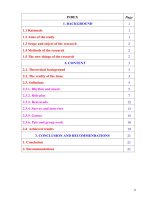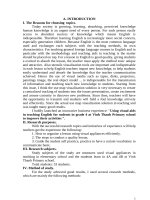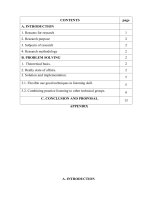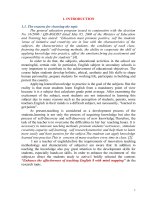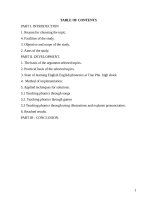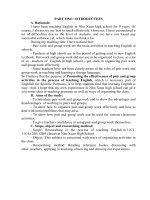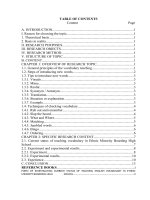The techniques of teaching english model sentences effectively and excitingly for students in grade 4
Bạn đang xem bản rút gọn của tài liệu. Xem và tải ngay bản đầy đủ của tài liệu tại đây (718.02 KB, 22 trang )
INDEX
1. BACKGROUND
Page
1
1.1 Rationale
1
1.2 Aims of the study
1
1.3 Scope and object of the research
2
1.4 Methods of the research
2
1.5 The new things of the research
2
2. CONTENT
3
2.1. Theoretical background
3
2.2. The reality of the issue
3
2.3. Sollutions
5
2.3.1. Rhythm and music
5
2.3.2. Role play
7
2.3.3. Real needs.
12
2.3.4. Survey and interview
13
2.3.5. Games
15
2.3.6. Pair and group work
18
2.4 Achieved results
19
3. CONCLUSION AND RECOMMENDATIONS
21
1. Conclusion
21
2. Recommendations
21
0
1. BACKGROUND
1.1. Rationale
Nowadays, English is regarded as one of the most popular languages for
people in the world because English is the important factor of all countries to
contact and work together. To catch up with the trend of global integration,
learning English are becoming more and more necessary and popular for everyone,
especially young learners 2018.
In order to satisfy this requirements, the Communist Party of Viet Nam and
the goverment have considered education as the most important national policy and
during the school year of 2018 – 2019, the Ministry of Education and Training
(MoET) implemented the model teaching of English subject to the students at
primary schools, in accordance with the project of foreign languages teaching in
the national education system, of the period 2010 – 2020 and also make English an
official subject in primary schools to help students get good foundations of English
and develop their English so that they can reach the European Standard. Teaching
English for children is not a simple work, especially model sentence teaching – the
necessary part to teach effectively. Each teacher has their own ways to teach model
sentences and in my opinion, if I want to teach them effectively, I have to handle a
range of varialbles. These include rhythm and music, role play, real needs, survey
and interview, games, and pair and group work. They are key factors for teacher to
teach model sentences easily.
For these reasons, I am interested in writing the iniatiave with topic: “The
techniques of teaching English model sentences effectively and excitingly for
students in Grade 4 which I am carrying out at Hoang Hoa Tham Primary School
in grade 4 with the hope of helping teachers teach English model sentences and
improve the quality of teaching English at Primary Schools.
1.2. Aims of the study
Researching on this topic helps teachers to teach English model sentences
effectively. Good English model sentence teaching techniques are essential in
creating the right condition for learning. And these well – taught techniques
provides the foundation on which a teacher can create a motivating and productive
learning experience.
1
1.3. Scope and objects of the research
With the reasearching subject is primary students in grade 4 at Hoang Hoa
Tham Primary School. They are students in grade 4A, 4B, 4C, 4D and 4E.
Apply for new Tieng Anh 4 that the Moets has changed in the school year
2018-2019
1.4. Methods of the research
Updating the new ways of teaching English so I choose the communicative
language approach and I always put the centre on learning and students.
1.5 The new things of the research
The new techniques of model sentence teaching that teachers can use to organnize
interesting activities in grade 4.
2
2. CONTENT
2.1. Theoretical background
Teachers play vital roles in the lives of the students in the classrooms.
Teachers set the tone of their classrooms, build a warm environment mentor and
nurture students, become role models, and listen and look for signs of trouble.
Therefore, if teachers do not teach model sentences – an important part of English
well teachers can not meet the above roles and students can not use English model
sentences in real life.
To carry out these solutions: Rhythm, Real need, role play, survery and
Interview, and Games will help teachers teach model sentences well and
interestingly. However it asks teachers to pay attention them all the time and repeat
them again and again for all the time. This means that the teachers have to be patient
to remain it so that they can teach English model senntences efficiently and
maximise the opportunities for student learning, practising and using in real life.
2.2. The reality of the issue
As a primary teacher of English, I realize that there are some real problems
in teaching English model sentences in grade 4 in my school.
a. Advantages
With the attention of the Board of Management to help the school, the siblings
preceded colleagues have created all conditions for teaching and learning English to
be better. There are sufficient textbooks and equipment such as tapes, discs, robot
teachers, speakers, software, Internet, Projector etc… for teaching and learning.
I myself was involved in training program of new English textbook 3,4; so I
master the syllabus, also the basic teaching methods. I know how to combine the
teaching techniques in order that my lessons can achieve high effectiveness.
There are many changes in the structure and appearance of the textbooks,
with more pictures and the topics which are more familiar to the students, so they
feel excited and very positive to learn English. Especially, students are aquainted
with informative technology early, they use computer, the Internet and they get a lot
of English resourses from here. Moreover, they have chance to take part in many
English pleasure grounds such as: English club, English Violympic, Ringing golden
bell…. These grounds help students develop and increase their English very much.
3
b. Disadvantages
Although the English subject is the chosing ones at Primary Schools at
Thanh Hoa City has been considered as important as Vietnamese and Maths
recently. However, teachers face with many difficulties and one of the most how to
help students to use English model sentences easily and effectively. Many experts
of English have been surprised that why teachers of English in Vietnam in general
and in Thanh Hoa in particularly, can teach model sentences for the big numbers of
students in one class. Teachers have to teach from 35 to 40 students in small rooms
therefore, this reality demands teachers to have good English model sentences
techniques to organize activities and creat good environment for students to learn.
There are 1016 students at Hoang Hoa Tham Primary School and each class
has about 38 students – a big number. The next difficult is limited teaching tools.
Moreover, the learners become more active and obstreperous so teachers try their
best to solve unexpected problems and get the good techniques of teaching model
sentences. I am on duty teaching English in grade 4 in Hoang Hoa Tham Primary
School. Before using the techniques of teaching English model sentences at the
beginning of school year’s survey showed that:
Class
Number of
students
Good
completement
Completement
No completement
Number
%
Number
%
Number
%
4A
43
13
30,2
27
62,8
3
7
4B
44
12
27,3
28
63,6
4
9,1
4C
38
10
26,3
24
63,2
4
10,5
4D
37
9
24,3
25
67,6
3
8,1
4E
38
12
31,6
23
60,5
3
7,9
This result is not really as good as I expected that has motivated me to think
and find a positive way to teach English model sentences better. From the current
situation in the process of teaching I have concerned and thought carefully to apply
some positive techniques of teaching English model sentences.
2.3. Sollutions
4
By studying psychology of elementary school children, I realized that
elementary school children are more playful, giddy than studious. Now I have been
applying teachniques of teaching English model sentences that fit with them to get
the best result in teaching and learning English.
2.3.1. Rhythm and music
*Aims:
In order to have positive learning environment I create a interesting way of
teaching model sentences. And the first step towards effective model sentence
teaching ways is to create a rhythm so that I can set up and control activities.
* Techniques
- As usual teachers aslo set the scence to help students to know about the
situation that they use the sentences. In order to make the students feel exciting
about the sentences teachers create new melody for sentences. For example: The
questions and answers about subjects in Unit 8 Lesson 1 of Tieng Anh 4.
(Education Press)
What subjects do you have today?
I have Maths, Vietnamse, Music and Art.
These sentences are quite long and boring if we only ask and answer as
usual, therefore teachers can clap the hands with the rhythm :
What subjects / do you have / today?
I have Maths, / Vietnamse, / Music / and Art.
After clapping 3 times teachers clap with the same rhythm but this rhythm is
quicker. This way draws my students’s attention and they learn in a comfortable
environment. As the result they remember the model sentences naturally.
In some cases I use rap music or funny music to teach sentence patterns. For
instance: With the model sentences: Can you swim? Unit 5 Lesson 2 of Tieng Anh 4
Can you play the table tennis?
Yes, I can
Can you play volleyball?
No, I can’t.
But in my opinion I create a rap song.
5
Can you play /table tennis?
Table tennis/, table tennis./ Yes, I can
Can you play /volleyball?
No, No, No,/ I can’t.
Students are practising the model sentencs with rap music.
When I say these sentences I shake my head, my body and stomp the feet
like a rapper. My students often laugh and take part in this activity enthusiastically.
I aslo feel happy and teach them more creatively.
I can sing so in some lessons I use the music of other songs to mix the
sentences and teach my students such as : “If you happy and you know” to teach
the following model sentences:
Hi, I’m Nam. Where are you from?
Hi, Nam. I’m Tom. I’m from America.
6
All students sing the model sentences with the music of the song
For the rules to be effective, the teacher should change the melody. If the
students feel the melody is unexciting teacher should use another rhythm.
2.3.2. Role play
* Aims.
Remembering and using model sentences can be a challenge and it is uneasy
for teachers to oraganize an interesting activity for the large number of noisy
children in one class from 35 to 40 students. I must have strategies to control them
and get their attention.
* Techniques
- The first strategy is opening situations that students feel interesting.
- Secondly, I use role play in group 2,3,4,5,6 etc (up to the situations).
Combining the actions and instructions helps to focus children more effectively.
- Moreover, teachers bring tools, lively teaching aid, teaching tools to the
lesson so that students see and know what topic they will learn.
- The other way is asking students to create roles if they like.
- The important thing to get attention of students is giving them a duty or a
role so that they think students make important roles in the play and make the
7
lessons be comfortable. This means the lessons seem not to learn and they become
playgrounds for students.
For illustration:
In students’ free time they often play roles such as mom, dad, son, daughter
so they love to show roles in learning. In unit 11 (What time is it ) of Tieng Anh 4
tap 2, I teach them dialogues that in part “Look, listent and repeat” by setting the
situation one student gets up late and mom ask their son to get up and ask “What
time is it?” The son answers about time and says that “Today’s Sunday and I
don’t have to go to school.”. I use alarm-clock, a small blanket, door, bench (and
explain it is a bed) as main tools for this play. Finally the son has to obey to have
breakfast with sleepy attitude. The student who plays the role mom expresses a
strict mom and the other student represents a lazy son. I see their enjoyness when
they play roles. They feel the become other person and find strange experiences
that they like.
They play the roles of the mother,the daughter’s friend and the daughter.
(In unit 13 “Would you like some milk?”lesson 2 part 1: Look, listen and repeat)
This picture in the lesson 2 of Unit “Would you like some milk? The
situation is a boy visits their friend’s house and his friend invites him a cake and
some other food and drink.
8
For example:
Would you like some cakes?
+Yes, please.
+ No, thanks.
A student invites his friend a cake
In the lesson Unit 1 “Nice to see you again” of Tieng Anh 4 tap 1, I give
them an opportunity as a teacher and say “Good morning” or “Good afternoon”
When all students stand up and greet teacher – the student play the role of the
teacher shows the proud feeling in their face clearly. They think their roles are very
important in the class and understand me (the teacher ) more than before. In this
play, tools are in advance in the class and teacher do not have to bring tools. It is
the fact that students plays roles of a teacher and students very well so that I think
they real teachers in the class at that time.
In the lesson of the job I use many job tools : a doctor’s shirt, a capacity, a
stethoscope (a doctor, or a nurse in a hospital) , a water tank, a scythe (a farmer), a
hammer, a spanner (a worker), etc….. These thing may be real ojects or toys. My
class is not a classroom it may be a place for my students to play and speak
English naturally.
9
And this is the first part (Look, listen and repeat) of the lesson plan that I
use role play technique.
GRADE 4
UNIT 12: WHAT DOES YOUR FATHER DO?
Lesson 1. Part 1,2,3 (Period 79)
I.
Objectives: Students will be able to ask and answer questions about
someone’s job.
II.
Language focus:
* Vocabulary: interview, partner, pairs, jobs, nurse, student, farmer,
driver, factory worker
* Sentence patterns:
What does your father do?
He’s a …..
III. Resources: ebook, software, computer, projector, Students’ books,
recording, flash cards, posters of the jobs, notebook, pen,board, school things in
the class. Tools of the jobs (a doctor’s shirt, a capacity, a stethoscope (a doctor, or a
nurse in a hospital) , a water tank, a scythe (a farmer), a hammer, a spanner (a
worker), etc )
Steps / Time
1.Warm
up
Learning activities
– Sing the song: “What does your father
do?”
Language
focus
Modes
Whole class
( 5 minutes)
2.Look,
-Teacher asks about the jobs they have
listen and learnt in the song and the jobs of
repeat.
some students’ parents. (They can use
(
15 Vietnamese)
minutes)
Whole class.
- Introduce the topic of the lesson is
jobs of family members.
- Students look at four pictures to
identify the context in which the
language is used.
10
- Ask and answer the questions such
as: Who are they? Where are they?
What are they talking about? Help
them to identify teacher – Miss Hien
is asking her students to interview
their partner about the jobs of his or
her family members. Nam is
interviewing Mai about the jobs of her
mother, father and sister.
- Teacher opens the recording of the
software –ebook, shows the actions,
body languages and guestures of the
roles in the conversation (plays all
roles).
-Ask students play the roles after
teacher.
+ In picture a, in the role of teacher all
students have to stand up,hold a book
and ask students to interview their
partneer about the jobs of his or her
family members. In the roles of
students they sit down and say “Yes.
Ok”.
+ In pictures b,c,d they stand up and
picking up a pen and a notebook and
interview the jobs of Mai’s father,
mother and sister do. When they say
they have to write in the notebook.
-Teacher play the role teacher Hien,
students plays the role students.
-Students play the role teacher Hien,
teacher play the role students.
11
-Group one is teacher Hien, group 2 is
Nam, group 3 is Mai.
- Ask students work in group of 3 and
play 3 roles in 3 minutes.
-Call 3 groups of team A, B, and C to
show the conversation in front of the
class. Which groups plays the roles
better will be the winner.
-Ask student to give comments about
their friends and correct if he/she has
mistakes.
-Groups
- Teacher gives feedback and give
stars
-Individually
After taking part in plays my students often laugh and contact each other
enthusiatically. I often push the story to become more lively by manifesting high
emotion with feeling faces and real actions, therefore; my students like plays very
much. It may be humorous or strict but all roles I also teach my students to imagine
they are real characteristics in real life not in books. In general each story, each
situation bring us happiness and a source of inspriation to learn and use model
sentences everyday.
2.3.3. Real needs
12
* Aims:
In real life and in imergency situations such as being tired, being thirsty,
being hungry or finding something that they need, they have to use some simple
sentences to express their need.
* Technigues
Beside the sentences they learn in Tieng Anh 4 text book I also supply my
dear students some other useful sentence patterns. For instance: If pupils want to
drink something they can say:
“I’m hungry. I’d like some noodles please.”
“ Here you are” is the respond they can reply.
“Do you know where my pen is?” The students can answer “It’s over
there/here.”
To get permision from other people my students certainly use the model
sentence:
- “May I use your ruler?” “ May I borrow your book?
- The sentence that answer for these permision is “Yes, you can.” or
you can’t”
“No,
The rule that I give for my students they do very effectively is using English to
manifest their need. If they do not do like that their demand will not be accepted And
we do not answer or give any things for them if they speak Vietnamese in the class.
In order to instruct students to understand what I want them to do. I know
that giving clear instructions make them short and concise. Before giving
instructions, therefore, I must ask myselve the following questions: What is the
important information I am trying to convey? What must the students know if they
are to complete this activity successfully? What information do they need first?
Which should come next? In short time, they know how to speak these sentences in
English fluently.
2.3.4. Survey and interview
*Aims:
- Setting up survey and interview is another key area of effective teaching
model sentences. Survey and interview have been popular in language teaching for
13
many years and have many advantages. They both foster cooperative activity in
that the students involved work together to complete the task. They may be
journalists or interviewees and ask each other about real information that connect
their family, their friends, their learning ect……
* Techniques.
- When we finish the activity “Point and say” in lesson 1 of unit 12: “What
does your father do?” we organise a survey about the jobs of the students’ parents.
I prepare 40 B2 paper and in each paper has the name of their friend and two rows
(one row is the job of father and the other is the job of their mother). My students
do the survey in 3 minutes and who finishes first will have a present. They try their
best to do and it is difficult for me to find who is the winner in the survey.
Name:
Father
Job:
Mother
Job:
- After the students have completed their work I wrap up an activiy and
check on students’ progress. I think that conducting feedback not only helps bring
the activity to a close, but signals to students that I care about their work they have
just completed. In my English class I usually use some ways I gather the feedback from
my students For instance, In unit 13: Would you like some milk? (Lesson 3 – part 4,5,6)
my students have just completed an interview their classmates about their favourite
food and drink.
The interview of my student
14
I ask “How many friends do you interview?” They answer the number they
have interview: three. I go to the seat of one student (Nguyen Thi Mai) and ask the
name of his friend he has interviewed and the favourite food and drink of his friend
and write these information on the board. Secondly, I ask Mai again to check the
information she has interviewed. Thirdly, I write the information on board : Linh –
Chicken – Lemonade. Then I ask all students some questions to check their
understanding “What’s her name? What’s her favourite food? What’s her favourite
drink?” write the report on the board : My friend’s name is Linh. She likes
chicken. It’s her favourite food. She likes lemonade. It’s her favourite drink.
Fourthly, I ask them to repeat the report some times. Fifthly, I order my students to
write one of 3 reports of their friends. Each report includes five sentences. They
aslo say aloud with your friends. Finally, I call some students to say about their
report in front of the class and other give comments.
- In pairs or groups, students tend to particiapte more actively, and they also
have more chance to experiment with the language than is possiple in a whole –
class arrangement. Pair or group work give students more opportunities to practise
the language and learn them from each other. However, these activities can be
difficutlt to set up. By ensuring that the students may understand exactly what they
need to do to complete the group work sucessfully, they will find it easier to stay
focused and learn more from the activity.
2.3.5. Games
* Aims:
Some activities may be too familiar with students and they want to have new
activites to practising model sentences in an exciting enviroment.
*Techniques:
+ Game 1: The name of the game: Selling goods
Application area: This game is applied for practiseing questions and
answers, respond sentences in new language lesson or in revisions. Teachers have
to introduce model sentences in periods.
The rule: I prepare some baskets of food, drink, and fruit. I divide class into
3 groups. Group one will sell food, group two will sell drink and the last group
sells fruit. I put these baskets in the middle of the groups. The leader of each
15
groups will give duty to their partners so that when I say I’d like any kinds of food,
drink or fruit they must bring them for me to buy. If they diliver goods slowly I
will deny my order and they can not sell their products.
+ Game 2: The name of the game: Ship
Some games help students to practise sentence patterns effectively.
Application area: This game is applied for practiseing questions and answers,
respond sentences in new language lesson or in revisions. Teachers have to
introduce model sentences in periods.
For example:
What day is it today? It’s Monday.
What is the date today? It’s the first of November.
What do you like doing? I like collecting stamps.
The way to do: divide class into groups (each group is a ship). The duty of
each ship member is answering the questions and make questions and call one
membership of the other group so that he or she can answer. If they answer well,
the process continues to carry out. If their friend team can not answer their ship
will be cut one hole. In 5 minutes if the ship has less holes than the other will be
the winner.
+ Game 3: The game’s name: I see something.
The target of this game is encouraging students to speak many English
model sentences and apply vocobularies that they have known in the sentences.
Application area: Teachers hold the games in revision to help students speak
more vocabularies and model sentences naturally.
The way to do: Divide the class into 2 groups. Teachers give them an equal
amount of pictures. The leader in team A will choose one picture but their friend in
team B can not see this picture and say “I see something” Team B will guess the
content of the picture. For example: In review 1 after my students learn about day,
monthe, date they can ask “Is it a day?/ Is it a month? Then if it is right they will
guess the detail day/month and everything that connect to this day/month: Is it
December? Is it the last day in the week? What can you do in this month? Can
you play games on this day? What do you do on Friday?
16
If the guess right the will receive this picture. In 10 minutes the team has more
pictures will be the winner.
Game 4: The name of the game: “Candy and spider”
Game: Candy and spider
Aims: To rivise the jobs and sentence patterns:
What does your…. do?
17
He/She’s a …..
The rule: Divide class into 4 groups from Group1 to group 4. Teacher invites
each group a representative to go to the board to play one, two and three to find the
order of groups. The winner in the play one, two and three will play first. On the
screen there is circle that appears a job picture that you have learned. After looking
at the picture the first person will go to the tray to choose a tool that matches with
the job picture. Whole class make a question and the first person will answer and
act to express the job. If that student answer and express the job right teacher flips
the back picture. If it is a picture of a candy student’s group will receive 3 stars and
if it is a picture of a spider student’s group only receive 1 star. If he/she anwers and
express wrong the right’s answer belong to the next group.
2.3.6. Pair and group work
Pair and group work are used to improve all 4 skills in English.
- Reading (Reading the text): Students read in silence and discuss the
questions in pairs.
- Talking (Practice speaking). Pair and group work have good effectiveness
in the speaking time and this is the featured approach of communicative language
teaching.” There are 3 levels of practising: Practising according to model,
controlled practise and free speaking practise. Teacher can carry out the activites
for student to speak in pairs or groups to give their opportunities to all students to
take part in speaking.
- Writing: Students discuss in pair of groups before writing and they can
exchange their writing to correct the mistakes.
- Listening: In listening tasks: Listen and tick, listen and number, listen and
circle, listen and fill the word listen and colour.), teachers ask them to discuss in
pairs or groups. Then they compare the result with other pairs or groups to find the
best answers.
- For example:
+ When I want to teach the model sentence: “Yesterday, I played badminton/
the piano/ table tennis/ watched TV” I demonstrate the activity in front of the
class: I say “Yesterday” then I act the action of playing badminton.
18
+ I ask student “What did I do” and students answer and I confirm “I played
badminton.” In the sentence “Yesterday, I played the piano.” I aslo say
“Yesterday” and give signals to my students by using the hand motion. Students
guess what I did and say aloud. Then I confirm the meaning of the action.
+ I invite one student go to the board and show one mime to his friends. He
acts he played table tennis. I ask him to sure: “You played table tennis. Is it right?”
If others is right I praise them. I also invite another student to mime.
+ Then I say that I divide them into two groups for each team. They sit
around the table. I physically count students into teams because I want to indicate
groups clearly. Two students in a group.
+ The next step I call all students in team A stand up to demarcate groups.
Team A members discuss with each other and choose one mime and show the
mime to team B carefully (Team B watch team A discussing) and team B have to
guess what they did yesterday? Team A have to say together “What did I do
yesterday?” This mean students repeat target language for reinforcement. I
emphasise that they have to show the body action. I ask 3 students in team B to
guess and students in team B have to show their action.
+ In oder to have signals to change the activity I clap the hand. I give them a
card of actions on the weekend and ask them to spread them on the table. I guide
them to play the game “snap the action” I get their attention to the cards on the
table and snap the card of action they hear the teacher says. Before snapping my
students asks me “What did you do yesterday?” I answer “I went to the zoo.” They
snap quickly the card as soon as possible and pick it up immediately. I repeat this
activity but I change some sentences: “I played basketball”
+ In order to make the activity more interesting the students have to switch
their seats and sing a song during the time they switch their seats. They sing a song
to put their hands on their heads and ask me again the question “What did you do
yesterday?” I say “ I watched TV”. When they hear my answer they have to pick up
the card of watching Tv quickly. I say two tables are winners. I do again some
times to practise the actions I did yesterday, however I ask them to speak out to
challenge their responding. Among the sentences I use the song and the chant to
motivate and focus my students on the activity and my instruction.
19
In the communicative language teaching approach, exercise kinds and
activities are suitable with this approach is unlimited as long as those activities
help students to get the objective of the unit and attract them to take part in
communicating process and information sharing process, discuss and interact.
2.4. Achieved results
After one year of teaching and applying the technique of teaching model
sentences, I noticed that my students understand and use sentences effectively.
For students, they are excited to learn and take part in activities that I organize in
the class and have a clear focus in acquiring and have a passion for the subject. The
quality of leanring increased significanlty compared to the first survey quality. The
results are as follow.
Class
Number of
students
Good
completement
Completement
No completement
Number
%
Number
%
Number
%
4A
43
18
41,9
25
58,1
0
0
4B
44
17
38,6
26
59,1
1
2,3
4C
38
15
39,5
22
57,9
1
2,6
4D
37
14
37,8
23
62,2
0
0
4E
38
17
44,7
21
55,3
0
0
3. CONCLUSION AND RECOMMENDATIONS
3.1.Conclusion
In the process of applying the techniques of teaching English model
sentences, I found that when I carry out a range of activities flexibily my classes
seem more effectively without wasting of time and energy. I hope that the findings
and suggestions in this initiative will be sort of supplementary information for
20
those who are interested in teaching sentences, especially a class with a large
number of students like mine.
3. 2. Recommendations
Although the initiative has accomplised the objectives set at the beginning, it
cannot avoid some limitations. Due to the shortage of time, the limite of
knowledge and experience as well as the scope of the study, the papers cannot
cover all the aspectss of the matter. Thus, there are many things left for further
studies. The subjects of the innitiative are grade 4 students at Hoang Hoa Tham
Primary School so that the learning condition as well as the other factors
concernning learning and teaching process may different from other areas.
However other colleagues can learn something from this and they can manage their
classes like the ways I do. Obviously, mistakes are unavoidable, all comments and
remarks on this innitiative will be highly appreciated.
I am looking forward to receiving your comments and siblings.
I sincerely thank you!
Confirmation of the Unit.
Thanh Hoa, March, 20th 2016
I hereby declare this initiative is written
by myself. Do not copy from any others
Writer
Duong Thi Thu Ha
Ly Thi Thanh Huyen
21

